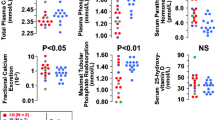Abstract.
Hypercalciuria was induced in female Sprague-Dawley rats, aged 40±2 days, by 7-day administration (mean±SEM) of calcitriol (5.4±0.1 ng/100 g per day, intraperitoneal), furosemide (14.9±1.9 mg/100 g per day, oral), or ammonium chloride (3.8±0.1 mEq/100 g per day, oral). Calciuria increased from 1.9±0.2, 1.6±0.2, and 1.9±0.3 to 5.4±0.5, 4.0±0.9, and 5.4±0.5 mg/100 g per day in the calcitriol (VD, n = 9), furosemide (F, n = 6), and ammonium chloride (AC, n = 10) groups, respectively. Calciuria did not change (1.9±0.3 vs. 1.6±0.1 mg/100 g per day) in control rats (n = 8). Ninety-six percent of treated rats became hypercalciuric as assessed by urine calcium excretion above the 90th percentile of normal values. Hypercalciuria was of similar degree in the three groups of rats and was not associated with hypercalcemia, metabolic acidosis, severe serum electrolyte imbalance, or growth impairment. VD rats had low serum parathyroid hormone (PTH) concentrations (3.0±0.5 pg/ml vs. 15.8±1.3 pg/ml in controls, P <0.05), whereas serum PTH was not significantly elevated in F rats (16.2±1.8 pg/ml). Thus, the protocol caused three forms of hypercalciuria that mimicked the clinical conditions of idiopathic hypercalciuria in humans and may clearly be differentiated according to their mechanism of production. This experimental model of normocalcemic hypercalciuria may be useful to clarify unknown aspects of pathogenesis and pathophysiology of idiopathic hypercalciuria in children.
Similar content being viewed by others
Author information
Authors and Affiliations
Additional information
Received March 12, 1997; received in revised form September 19, 1997; accepted September 24, 1997
Rights and permissions
About this article
Cite this article
Ordóñez, F., Fernández, P., Rodríguez, J. et al. Rat models of normocalcemic hypercalciuria of different pathogenic mechanisms. Pediatr Nephrol 12, 201–205 (1998). https://doi.org/10.1007/s004670050437
Issue Date:
DOI: https://doi.org/10.1007/s004670050437




